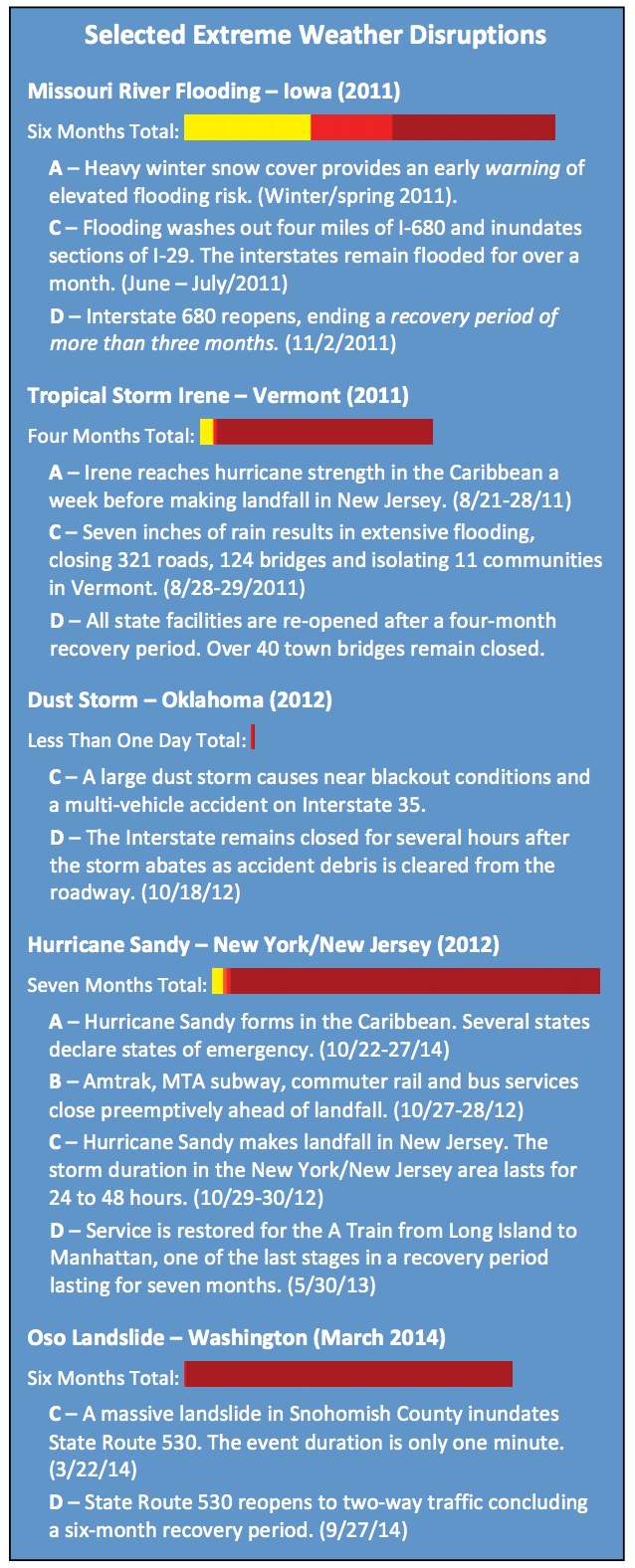NATIONAL CENTER FOR SUSTAINABLE TRANSPORTATION
THE UNIVERSITY OF VERMONT TRANSPORTATION RESEARCH CENTER
Challenges and Opportunities for Integrating Climate Adaptation Efforts across State, Regional and Local Transportation Agencies
Disruptions caused by extreme weather events are imposing significant and rising costs on transportation agencies throughout the United States, and climate change is projected to increase both the frequency and severity of these events. In response, transportation agencies and organizations are exploring climate adaptation measures. This white paper presents a fivestep transportation adaptation framework synthesized from common elements of an array of existing resources, and assesses the state of the practice within each of the five steps. The five steps are:
1) inventorying and monitoring transportation assets;
2) assessing climate threats;
3) evaluating asset vulnerability;
4) rating asset importance or criticality; and
5) identifying and executing adaptation actions.
 The objective of establishing a common framework is to facilitate broader discussion among transportation agencies and their partners in order to identify current adaptation barriers and opportunities for interregional and interagency collaboration.
The objective of establishing a common framework is to facilitate broader discussion among transportation agencies and their partners in order to identify current adaptation barriers and opportunities for interregional and interagency collaboration.
The roles for state and local agencies in implementing these steps have yet to be clearly delineated. Our review indicated implementation barriers exist in each step but can be reduced through collaboration. Because the surface transportation system functions as an integrated unit that crosses multiple jurisdictional boundaries, collaboration among state, local and regional transportation agencies is essential to maximize the efficiency and effectiveness of overall adaptation efforts, especially since many local agencies face significant resource limitations.
The first step in climate adaptation planning, inventorying transportation assets, is conceptually straightforward and best undertaken by the agencies that own and manage transportation infrastructure. However, maintaining these databases can be costly and time consuming. Thus the biggest challenge at the state level is the resources required to develop and maintain these inventories. At the sub-state level, many smaller agencies lack the technical experience to develop asset databases. State leadership setting uniform asset database standards would facilitate the data integration required for other steps in the adaptation planning process.
The second step in climate adaptation planning is to assess climate threats. While many transportation agencies understand the types of climate threats they face in general terms, advances in climate modeling and model downscaling will be needed to support policy decisions and the development of new design standards. Broader consensus on the appropriate emissions/climate change scenarios to use for planning purposes, including cost benefit analysis, is also essential. Conducting climate threat assessments at the state level, likely in collaboration with partners outside the transportation sector, will provide efficiency benefits.
The third step in climate adaptation planning is to evaluate each asset’s vulnerability to the threats identified in step two. Vulnerability is a function of the type, magnitude and probability of the climate threats. Given the uncertainties in step two, this step is technically feasible but challenging. A number of state department of transportation (DOT) officials indicated that more precise vulnerability modeling tools would be valuable and that uncertainty about the magnitude of future weather-related threats complicated vulnerability assessment.
The fourth step in the framework is to rate the relative importance or criticality of all infrastructure in the system. Given the resource constraints facing transportation agencies, criticality ratings are necessary in order to prioritize adaptation projects, but methods for assessing criticality are not fully developed, leaving project prioritization vulnerable to politicization. Agencies often rely on metrics such as traffic volumes that do not account for network connectivity and redundancy effects. It is clear, moreover, that criticality assessment is fundamentally cross-jurisdictional and cross-modal. National leadership is needed to develop criticality rating methods suitable for complete, multimodal, regional transportation networks.
The fifth step in the framework is to identify, select and execute adaptation actions. Adaptation actions can involve infrastructure or processes. Infrastructure adaptations include physical changes to infrastructure to reduce its vulnerability (“hardening”), adding infrastructure to increase redundancy, and potentially relocating or abandoning assets. Analysis of the costs and benefits of infrastructure adaptations can be challenging due to multiple temporal scales for infrastructure life and weather event return periods. Currently process adaptations, such as improved pre- and post-disaster response planning, are more common because they can be undertaken even with considerable uncertainty about the magnitude of future climate threats.
All steps in the adaptation planning process are iterative and interconnected. Once implemented, adaptation actions frequently impact the whole system and require ongoing monitoring and changes to asset inventories, vulnerabilities and criticality assessments.
About the National Center For Sustainable Transportation
ncst.ucdavis.edu
The University of California, Davis, Institute of Transportation Studies (ITS-Davis) was selected in a national competition in September 2013 to lead a new two-year, $11.2 million research, education, and outreach consortium for the U.S. Department of Transportation.
About the University of Vermont Transportation Research Center
www.uvm.edu/trc
Vermont’s Transportation Research Center (TRC) is a hub for innovative and interdisciplinary research, education and outreach on sustainable transportation system solutions. The TRC focuses on transportation planning as it relates to resilience, energy and health.
Tags: extreme weather, National Center for Sustainable Transportation, UC Davis, University of California, University of Vermont, University of Vermont Transportation Research Center






 RSS Feed
RSS Feed